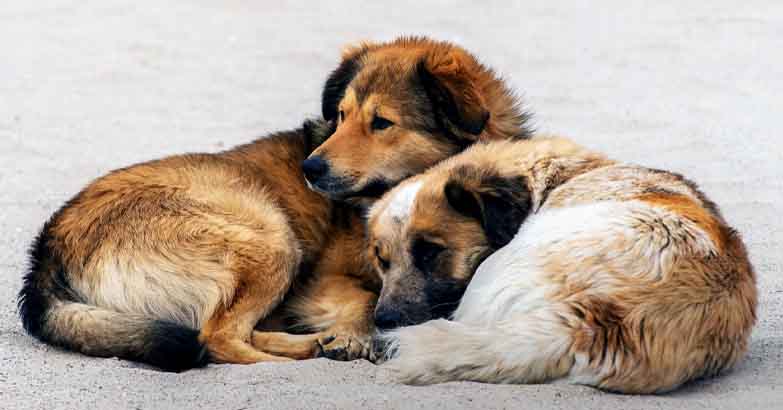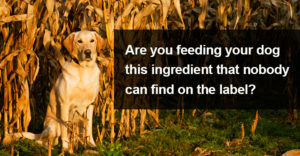The statistics for cancer in dogs are frightening. About half of dogs over 10 years old will develop cancer, with 6 million new cases each year.
- 23% of all dogs die of cancer
- 45% of dogs over 10 die of cancer
- For some breeds it’s high as 65%
The high risk means it’s important as a dog owner to learn about the causes of cancer in dogs, so you can do all you can to prevent it. We’ll also talk about prevention, as well as warning signs of cancer and some of the most common types of cancer in dogs.
Causes Of Cancer In Dogs
While it’s impossible to avoid everything that could contribute to your dog’s cancer risk, here are some important factors you may be able to control …
Diet
Kibble contains several toxic ingredients that could lead to cancer …
- Aflatoxins
- Pesticides and herbicides (including Roundup/glyphosate)
- Heterocyclic amines and acrylamides, created by high cooking temperatures
- PBDEs – flame retardant chemicals found in kibble, likely due to high heat processing
- Food dyes – made from petroleum products (reds and yellows are worst)
- Carbohydrates – starchy diets high in carbohydrates are known to feed cancer cells, which thrive on sugar
- Preservatives – like BHA, BHT, ethoxyquin, benzoic acid, sodium benzoate, can damage the liver and cause cell mutations
- Propyl gallate – potential carcinogen
- Seed oils – high in omega-5 fatty acids, highly processed seed oils promote inflammation
Read more about cancer-causing dog foods …
Chemical Exposure
Avoid chemicals wherever possible in your dog’s environment, including …
- Vaccines and drugs
- Pharmaceutical pest protection
- Lawn chemicals (shown to cause lymphoma and bladder cancer in dogs)
- Exhaust fumes
- Secondhand smoke
- Contaminants in water – arsenic, asbestos, lead, agricultural chemicals, pharmaceuticals
- Cleaning products and artificial perfumes at home
- Plastics – BPAs
For more information on cancer-causing chemicals, read the Environmental Working Group’s Dirty Dozen: Cancer Prevention Edition.
Spay/Neuter
Spaying or neutering your dog can increase the risk of many types of cancer.
- 3 times lymphosarcoma rates in Golden Retrievers
- 4 times hemangiosarcoma rates in all female dogs
- 3 times increased prostate cancer risks in male dogs (despite what many claim)
- 3.8 times osteosarcoma rates in Rottweilers neutered under 1 year
Cancer Prevention In Dogs
Preventing cancer in dogs means avoiding or minimizing the causes described above. This includes feeding the best diet you can afford, avoiding toxins in your dog’s food and environment (including your home and yard), minimizing vaccines and pharmaceutical drugs, and keeping your dog intact.
Warning Signs Of Cancer
Here are some potential early signs of cancer that are worth getting checked by your vet …
- Lumps, unexplained swelling
- Behavioral changes
- Loss of appetite
- Digestive changes, frequent unexplained diarrhea or vomiting
- Abnormal bleeding (in vomit, stool, or nasal discharges)
- Sudden lethargy – even if your dog is older
- Enlarged lymph nodes
- Itchy skin (another sign of chronic inflammation)
- Any chronic problem (means your dog’s body isn’t functioning normally)
Don’t ignore symptoms and let them go on. Especially avoid using drugs to suppress symptoms, because that can drive them deeper and cause worse problems.
Be especially alert to changes if your dog is over-vaccinated, eats kibble, or gets pharmaceutical heartworm, flea and tick meds. You may also want to monitor bloodwork, and follow up on results like elevated calcium, white blood count or lymphocytes … or very low blood glucose.
Check for inflammatory markers, because inflammation predisposes your dog to cancer. VDI Labs offers tests for various wellness markers, including …
- C-reactive protein
- Vitamin D levels
- Vitamin B12 levels
- Cancer risk assessment
Common Types Of Cancer In Dogs
Here are some of the types of cancer dogs get …
Hemangiosarcoma
Hemangiosarcoma is a cancer of the blood vessel lining that’s about 0;2% to 3% of all canine cancers. It’s more common in middle aged or older dogs. Pink-skinned dogs can be prone to skin hemangiosarcoma.
Unfortunately, hemangiosarcoma is a very difficult cancer to spot because dogs often don’t have any visible signs or symptoms. However, it’s not a painful disease for your dog.
Mast Cell Tumor
Mast cells are part of your dog’s immune system and a response to allergies or parasites. Not all mast cell tumors are malignant.
Mast cell cancer is usually on the skin … but sometimes in other organs. Dogs who suffer from allergic reactions may be more likely to develop mast cell tumors.
Lymphoma
Lymphoma is most common in middle aged dogs, 6 to 9 years old, but can happen in younger dogs too. Dogs with compromised immune systems are more susceptible. Exposure to herbicides, electromagnetic radiation or industrial chemicals are other risk factors.
Lymphoma often appears as swollen lymph nodes (glands) under the neck …or in front of the shoulders or behind the knee. Some forms of lymphoma may be internal and you won’t feel them.
Osteosarcoma
Osteosarcoma represents about 85% of bone cancers in dogs. The first sign you’ll likely see for this cancer in your dog is persistent lameness or swelling. It’s more common in middle aged dogs, and taller, heavier dogs.
Dog Mouth Cancer
Mouth cancers are fairly common cancers in dogs. Symptoms of mouth cancer include mouth swelling, excessive drooling, bad breath or difficulty eating.
Leukemia In Dogs
Leukemia in dogs is a cancer of the blood cells. It can be either chronic or acute. Both are manageable but not usually curable.
Acute leukemia means leukocytes (bad blood cells) reproduce rapidly, and red and white blood cell counts will be too low, causing a weakened immune system. Chronic leukemia progresses more slowly over time.
Acute leukemia is more common in middle aged dogs (5-6 years), with chronic leukemia more common in older dogs. Leukemia cells can spread through the blood to other organs like kidneys or liver.
Testicular Cancer In Dogs
Testicular cancer can happen in any intact male dog, but usually in older dogs. The risk of testicular cancer is often used as an excuse to persuade you to neuter your male dog … but there are also many health reasons not to neuter him. If your dog does develop it, most cases are easily remedied by castration at that time. Cryptorchid dogs (with a retained testicle) are at higher risk.
Signs of testicular cancer in dogs include scrotal swelling or lumps.
Stomach Cancer
While not as common as other cancers in dogs, stomach cancer can be traumatic because dogs will usually have no symptoms until it’s in advanced stages.
Thyroid Cancer
Thyroid cancer is fairly rare in dogs, but thyroid tumors are nearly always malignant and spread to other parts of the body, like lungs, lymph nodes, blood vessels, windpipe, and esophagus.
Other Types Of Cancer In Dogs
Brain Tumors
There are several different kinds of brain tumors in dogs. The most common forms are:
- Meningioma – tumor in the membranes around the brain and spinal cord, called meninges.
- Glioma – tumor in the brain’s supportive tissues.
Brain tumors are more likely in middle aged dogs, 7 or older. Key signs of brain tumors in dogs can be seizures, behavior changes, unsteady walking, vision loss, neck or head pain (watch for head tilting).
Bladder Cancer In Dogs
Bladder cancer is fairly rare … about 1-2% of all dog cancers. There are two formal names for it: Transitional cell carcinoma (TCC) or urothelial carcinoma. Lawn chemicals are a known risk factor for bladder cancer in dogs.
The disease is slow to develop, and dogs may not show symptoms for 3 to 6 months. Urinary obstruction and bleeding are common signs.
Mammary Cancer In Dogs
Breast cancer can happen in any female dog, though intact dogs are at higher risk. About 40-50% of female mammary tumors are malignant. Male dogs can occasionally get mammary tumors as well … and when they do, they’re usually malignant. High fat diet and obesity may increase the risk of mammary tumors.
Malignant Histiocytosis
This is a less common dog cancer that comes from abnormal levels of a type of white blood cell called the histiocyte. The histiocyte is part of the immune system that lives in the body’s connective tissues and removes invading organisms. When it’s malignant, the histiocyte cell spreads aggressively in several different places at once, like the spleen, lymph nodes, lungs, bone marrow, skin, brain and joint tissue.
Squamous Cell Carcinomas
These are skin cancers in the squamous layer (epithelium) of outer skin cells. Squamous cell carcinomas are most often in the mouth … or the nail beds of the toes (called sublingual tumors). They account for 5% of all skin cancers in dogs. They’re more common in dogs who live at high altitudes … or spend a lot of time in the sun. Large breed black dogs are more prone to squamous cell carcinomas on the toes.
Early signs of this cancer may be a raised bump or white skin mass on your dog, that may ulcerate and bleed. Toenails may fall off or get infected.
Nose Cancer
Nasal tumors are locally aggressive, often spreading to surrounding tissues. Signs of nasal cancer in dogs are abnormal discharge, bleeding, snoring or trouble breathing.
Liver Cancer In Dogs
Liver cancer usually involves a hepatocellular carcinoma, which is a single, large tumor in the liver. It doesn’t usually spread to other body parts but it often doesn’t cause noticeable symptoms so it can be a silent killer.
Melanoma
Melanomas come from pigment-producing cells called melanocytes, so they’re more common in dark-skinned dogs. Melanomas can take different forms:
- Oral (mouth) – 80-85% of melanomas, often with metastasis
- Subungual (nail bed) – 15-20% of melanomas
- Cutaneus (skin) – often, but not always, benign
- Eyes (ocular) – usually benign
Signs of these melanomas can be lumps or bumps, changes in existing growths or skin color … or mouth problems like drooling, swelling, loose teeth or trouble eating.
Prostate Cancer In Dogs
There are many diseases that can affect the prostate in dogs, but prostate cancer is quite rare. And despite what many vets say when they’re encouraging you to neuter your dog, prostate cancer usually affects neutered, not intact male dogs. When it does happen, it’s usually aggressive and difficult to treat.
Lung Cancer In Dogs
There are a number of problems that can affect the lungs and cause owners to suspect lung cancer. But lung cancer in dogs is quite unusual, representing about 1% of all dog cancers. There are two types of lung cancer, primary and metastatic.
Primary lung cancer tumors are often malignant, diagnosed via chest x-ray that shows a mass on the lung. Metastatic lung cancer means a cancer that started elsewhere in the body has spread to the lung.
When lung cancer does occur, it’s quite aggressive and can spread fast.
Conventional Treatment For Cancer In Dogs
If your dog develops cancer, you’ll have some treatment decisions to make. Most conventional cancer treatments involve chemotherapy, radiation or surgery … and sometimes all three.
Chemotherapy Drugs For Dogs
There are several different types of chemo drug, that work in different ways, usually by killing cells or stopping them from dividing.
Side effects of chemo are similar to those in people, although some experts claim they’re milder in dogs due to lower dosages. But a major side effect is that chemo drugs kill normal cells as well as tumor cells. They reduce red and white blood cell counts, which lowers immune function and can lead to higher overall disease risk. After chemotherapy treatments, your dog may experience nausea, vomiting, lethargy, appetite loss, or diarrhea. Dogs don’t usually lose their hair like people do with chemo.
Radiation For Dog Cancer
Radiation is commonly used to target local cancer sites, as well as those where chemo or surgery alone aren’t enough. It works by stopping cancer cells from replicating, and it may provide palliative effects, reducing symptoms like bleeding or pain.
Radiation may be done before surgery to try to shrink tumors, or afterwards, to clean up cancer cells that remain. It usually requires sedation or anesthesia, as your dog must be completely still for the treatment.
Immediate side effects include skin redness or discomfort, hair loss, occasionally nausea or vomiting. Chronic side effects may be scar tissue formation and reduced wound or fracture healing. Secondary cancers at the radiation site may develop, sometimes years after the original treatment.
Because of potentially harmful side effects of these treatment options, you’ll want to do your research before making a decision. The Dog Cancer Survival Guide is a helpful book that explains a lot of the treatment pros and cons, as well as how the different chemo drugs work.
Surgery for Cancer In Dogs
Surgery is often recommended in cancer patients. There’s a risk to any surgery … and in cancer patients, removing a tumor doesn’t remove the underlying cause of the cancer. This means the tumor may reappear or grow somewhere else in the body.
There are a couple of emerging treatment options that may prove successful in future.
Immunotherapy For Cancer In Dogs
Immunotherapy stimulates the immune system to fight cancer cells. However, these treatments are in their infancy. The research into canine tumors is not as advanced as in humans, so the options are still limited. It’s often hard to predict whether a dog will respond to the treatment.
Cancer Vaccines
Several studies are under way into vaccines to prevent and treat cancer in dogs. Again, there’s a good deal of research still to be done, so these aren’t an option presently.
Natural Treatments For Cancer In Dogs
There are many ways to manage cancer with natural remedies and treatments. These can often be as effective as conventional treatments, and may result in improved quality of life for your dog.
Click on the header above to read more about natural cancer treatments.















